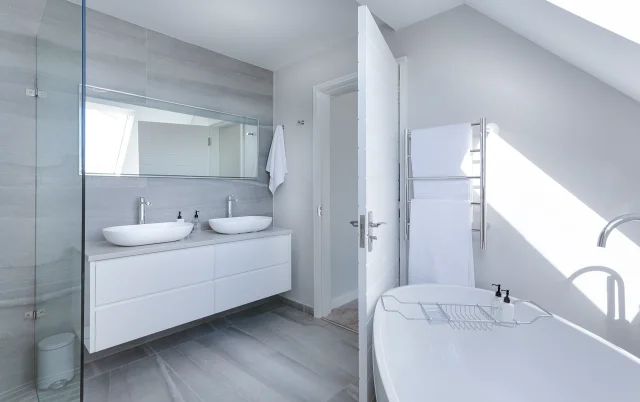Mold in the bathroom can be both unsightly and unhealthy, often thriving in moist environments. This article provides a comprehensive guide on how to get rid of mold in the bathroom, covering everything from basic removal techniques to prevention strategies and professional remediation services. With practical advice and proven methods, you’ll learn how to tackle mold issues head-on and maintain a clean, mold-free bathroom.

Please check our homepage for the latest articles and our blog with several ideas and tips for your home.
Contents
- 1 Key Takeaways: how to get rid of mold in the bathroom
- 2 Understanding Mold Removal Basics
- 3 Effective Cleaning Techniques for Bathroom Mold
- 4 Preventing Mold Recurrence in the Bathroom
- 5 DIY Mold Removal Strategies
- 6 Professional Mold Remediation and When to Seek Help
- 7 Conclusion
- 8 Frequently Asked Questions
- 8.1 How can I identify different types of mold in my bathroom?
- 8.2 What safety precautions should I take when removing mold?
- 8.3 What natural remedies can I use to clean mold in the bathroom?
- 8.4 How can I prevent mold from coming back after cleaning?
- 8.5 When should I consider hiring a professional for mold remediation?
- 8.6 Can I use bleach to kill mold, and is it effective?
Key Takeaways: how to get rid of mold in the bathroom
- Identify the type of mold present in the bathroom to determine the appropriate cleaning solution, from natural remedies like vinegar to stronger chemicals like bleach.
- Employ safety measures such as proper ventilation and protective gear when cleaning mold to prevent health risks.
- Prevent mold recurrence by improving bathroom ventilation, controlling humidity levels, and adhering to a regular cleaning schedule.
- Explore DIY strategies like homemade cleaning mixtures and using dehumidifiers, but also know when to seek professional help for stubborn mold issues.
- Understand that long-term mold prevention requires addressing the underlying moisture problems and possibly investing in specialized mold remediation products.
Understanding Mold Removal Basics

Identifying Types of Mold
Recognizing the type of mold in your bathroom is crucial for effective removal. Mold requires moisture to grow, and its presence indicates a moisture problem. To tackle mold, you must first identify it:
- Black Mold: Often found in damp, warm areas and may pose health risks.
- Aspergillus: Commonly appears on walls and can vary in color.
- Cladosporium: Usually green or brown, thriving on both warm and cold surfaces.
Mold’s “roots” can penetrate surfaces, making thorough removal essential. EPA-approved products can effectively reach and eliminate these roots.
Understanding the mold type helps in choosing the right cleaning approach. For persistent issues, consider professional mold remediation services that offer long-term solutions.
Safety Precautions for Mold Removal
When dealing with mold removal, safety should be your top priority. Mold spores can be harmful, especially when disturbed during cleaning. Here are some essential safety tips:
- Wear protective gear, including gloves, goggles, and an N95 mask to prevent inhalation of spores.
- Ensure good ventilation in the bathroom by opening windows or using an exhaust fan.
- Never mix cleaning agents, such as bleach and ammonia, as they can produce toxic fumes.
Remember to always read and follow the instructions on cleaning products to avoid mishaps and health risks.
If you experience symptoms like eye irritation or respiratory issues, leave the area immediately and seek fresh air. For those with mold allergies or compromised immune systems, consider seeking professional help for mold removal.
Choosing the Right Cleaning Solutions
When selecting the right cleaning solutions for bathroom mold, consider both efficacy and safety. Start with basic solutions like vinegar and dish soap, which are effective for various types of stains and safe for most bathroom surfaces. For tougher mold problems, a baking soda solution can be applied first to loosen the material, followed by a bleach treatment for thorough removal.
- Vinegar and dish soap: Safe for porcelain, acrylic, and fiberglass.
- Baking soda solution: Ideal for initial scrubbing.
- Bleach: Use for persistent mold colonies.
Remember to ventilate the area by opening windows or using an exhaust fan, and always wear gloves to protect your hands. While these solutions can be effective, regular maintenance is crucial to prevent mold and the accompanying sewage smells in bathrooms, which can be caused by dry P-traps and microbial buildup.
Effective Cleaning Techniques for Bathroom Mold

Natural Remedies: Vinegar and Water Solution
Vinegar, a household staple, is a powerful ally in the fight against bathroom mold. Its acetic acid content makes it an effective mold killer, safe for use on most bathroom surfaces.
To create a vinegar and water solution, mix equal parts of white vinegar and water in a spray bottle. Apply the mixture to the moldy area, allowing it to sit for several minutes before scrubbing. For tougher stains, let the solution work overnight.
Remember, vinegar should not be used on stone surfaces as it can cause etching.
Here’s a simple guide to using the vinegar solution:
- Spray the vinegar and water mixture onto the mold.
- Wait 5 to 10 minutes for the solution to penetrate the mold.
- Scrub the area with a brush or sponge.
- Rinse thoroughly with water and repeat if necessary.
For persistent mold, consider a follow-up treatment with a paste of baking soda and hydrogen peroxide.
Chemical Solutions: When to Use Bleach
While bleach is often regarded as a potent disinfectant, its use in mold removal is controversial and generally not recommended by experts. Bleach can cause the mold to become invisible by bleaching it, but this does not ensure that the mold is completely eradicated.
Bleach’s high VOCs can irritate the lungs, and its caustic nature may damage surfaces. The EPA has not approved bleach for mold control, emphasizing the need for caution.
Here are some considerations when thinking about using bleach for mold removal:
- Bleach is not an effective mold killer for porous surfaces.
- It can potentially release toxic chlorine gas, posing health risks.
- There is a lack of official guidelines for personal protection when using bleach.
In summary, bleach should be used with extreme care, if at all, for mold removal. Alternative methods and products are often safer and more effective.
Specialized Mold Remediation Products
When tackling bathroom mold removal, specialized products can offer a more targeted approach than general household cleaners. These products are formulated to not only remove mold but also prevent its return.
- Smart Touch: An EPA-registered, non-toxic disinfectant, effective for eradicating mold on contact.
- Mold Growth Inhibitors: These solutions are designed to create a barrier that deters mold growth, ensuring long-term protection.
For a comprehensive mold removal, it’s essential to address the root cause. Specialized products can penetrate porous surfaces, reaching mold at its source and providing a lasting solution.
Remember, while DIY methods can be effective for minor mold issues, persistent or large-scale infestations may require professional assessment and treatment. Always follow the manufacturer’s instructions and prioritize safety when using any mold remediation products.
Preventing Mold Recurrence in the Bathroom

Improving Bathroom Ventilation
Proper ventilation is crucial in the fight against bathroom mold. Ensure your exhaust fan runs for several minutes post-shower to effectively manage moisture. Additionally, opening windows and doors after bathing aids in moisture dissipation, thwarting mold’s return.
- Open windows to let out steam
- Use exhaust fans during and after showers
- Keep doors open to circulate air
Consistent airflow is key to preventing mold growth by keeping surfaces dry and reducing humidity.
Remember to dry towels, shower curtains, and bath mats regularly. This simple habit can significantly reduce the likelihood of mold taking hold in your bathroom.
Controlling Humidity Levels
Maintain indoor humidity below 50% to inhibit mold growth. Use dehumidifiers and air conditioners to achieve this, especially during hot, humid months.
- Ventilation: Run exhaust fans after showers and open windows to aid moisture dissipation.
- Dry Wet Items: Towels, shower curtains, and bath mats should be dried after use to prevent mold-friendly environments.
- Fix Leaks: Promptly repair any leaks in faucets, roofs, or pipes to eliminate moisture sources.
Consistently managing humidity levels is crucial for a mold-resistant bathroom. Regularly monitoring and adjusting indoor humidity can prevent the conditions that allow mold to thrive.
Regular Cleaning and Maintenance Tips
Regular cleaning is key to preventing mold growth in your bathroom. Establish a routine to ensure surfaces stay mold-free.
- After each use, quickly wipe down the tub and shower walls to prevent soap scum accumulation.
- Perform a thorough cleaning of your bathroom on a weekly basis, focusing on areas prone to moisture.
- Address leaky faucets promptly to avoid excess water that can foster mold.
Consistency in cleaning and maintenance is crucial. Simple habits, like wiping surfaces dry, can significantly reduce the likelihood of mold recurrence.
Remember, the goal is to maintain a dry and clean environment. Use a squeegee after showers, and consider an eco-friendly cleaner for regular use. By adhering to these practices, you can maintain a mold-free bathroom.
DIY Mold Removal Strategies

Homemade Mold Cleaning Mixtures
Creating your own mold cleaning mixtures can be both cost-effective and safe for your home environment. Baking soda and vinegar are two common household items that can be used to combat mold. Here’s a simple recipe:
- 1 part water
- 1 part white vinegar
- 2 parts baking soda
Mix these ingredients to form a paste, apply to the moldy area, and scrub with a brush. For tougher mold, you may need to let the mixture sit for a few hours before scrubbing.
Remember, consistency is key. Apply the mixture regularly until the mold is completely removed.
While homemade solutions are great for small areas, they may not be as effective for larger infestations. In such cases, consider professional-grade products or seeking help from a specialist.
The Role of Dehumidifiers and Air Conditioners
Dehumidifiers and air conditioners are critical in maintaining low humidity levels, which is essential for preventing mold growth in bathrooms. By extracting excess moisture from the air, these devices help create an environment that is less conducive to mold proliferation.
- Dehumidifiers: Aim to keep indoor humidity below 50%.
- Reduce dampness, especially after showers or baths.
- Can be particularly effective in naturally humid climates or during wet seasons.
- Air Conditioners: Not only cool the air but also remove moisture.
- Use during hot, humid days to maintain a dry and cool environment.
- Regular maintenance ensures optimal performance in humidity control.
Consistent use and proper maintenance of dehumidifiers and air conditioners are key to preventing mold. Ensure these appliances are functioning correctly and are used especially after high moisture activities, like taking a hot shower.
Sealing and Protecting Surfaces from Mold
After mold removal, it’s crucial to seal and protect surfaces to prevent future growth. Use EPA registered products like Common Sense Surface Protectant, which bonds chemically to surfaces, creating a barrier against mold, algae, and bacteria.
For porous surfaces, opt for mold remediation products that penetrate deeply, eradicating mold at its roots. Addressing underlying moisture issues is also essential for lasting protection.
- Apply EPA approved mold inhibitors
- Use ‘Ready To Use’ products for convenience
- Tackle moisture problems to prevent recurrence
Consistent application of protectants and regular maintenance can significantly reduce the likelihood of mold returning.
Remember, prevention is key. Regularly inspect and maintain areas prone to moisture, such as grout, and promptly repair any leaks to keep your bathroom mold-free.
Professional Mold Remediation and When to Seek Help

Recognizing Stubborn Mold Problems
When mold persists despite your best cleaning efforts, it’s time to evaluate the situation more critically. Stubborn mold can indicate deeper issues that simple surface cleaning can’t resolve.
- Look for recurring mold in the same spots, which suggests an ongoing moisture problem.
- Check for mold on porous materials like wood or drywall, as these can harbor mold beneath the surface.
- Be aware of musty odors, which often accompany hidden mold growth.
Addressing the root cause is essential. Without tackling the underlying moisture issues, mold will likely return.
If you’re frequently finding mold on bathroom walls, as noted by Family Handyman, consider the material of your walls and the effectiveness of your cleaning solutions. For non-porous surfaces, a natural remover might suffice, but porous surfaces often require specialized treatment. Recognizing when mold problems are beyond the scope of DIY solutions is crucial for the health of your home and family.
Hiring a Mold Remediation Specialist
When the battle against mold surpasses the efficacy of DIY methods, hiring a mold remediation specialist becomes essential. These professionals are equipped with the knowledge and tools to not only remove the mold but also to prevent future outbreaks.
- Assessment: A thorough examination of the affected area is conducted to determine the extent of the mold problem.
- Containment: To prevent the spread of mold, specialists will isolate the area.
- Removal: Using advanced techniques and products, the mold is carefully removed.
- Restoration: Damaged materials are repaired or replaced, and the area is restored to its original condition.
It’s crucial to address mold issues promptly to maintain a healthy living environment. Professional remediation ensures that mold is not just cleaned but eradicated, with measures taken to safeguard against its return.
Long-Term Solutions for Mold Prevention
Ensuring a mold-free bathroom requires more than just occasional cleaning; it involves adopting a proactive approach to mold prevention. Here are some strategies to keep mold at bay:
- Maintain Dry Conditions: Mold thrives in moisture. Use dehumidifiers and air conditioners to keep humidity levels low.
- Use Mold Inhibitors: Apply EPA-registered mold growth inhibitors to surfaces after cleaning to prevent mold recurrence.
- Fix Water Leaks: Address any plumbing issues promptly to eliminate moisture sources.
For lasting results, tackle the root cause of mold by using products designed for deep penetration on porous surfaces and addressing humidity issues.
Remember, while DIY methods can be effective, severe mold problems may require professional intervention. Services like Microbe Solutions offer non-toxic, long-lasting treatments that not only eliminate existing mold but also prevent future growth.
Conclusion
In conclusion, effectively eliminating mold from your bathroom requires a combination of thorough cleaning, proper ventilation, and moisture control. From using a simple vinegar and water solution to specialized mold remediation products, the key is to address both the visible mold and its underlying causes. Remember to wear protective gear when cleaning and to maintain low humidity levels to prevent future growth. With the right approach and regular maintenance, you can keep your bathroom mold-free and maintain a healthy living environment.
Frequently Asked Questions
How can I identify different types of mold in my bathroom?
Different types of mold can vary in color, texture, and location. Common bathroom molds are often black, pink, or green. Black mold is usually found on damp walls, while pink mold often appears on shower curtains and tiles. To accurately identify mold types, consider consulting a professional.
What safety precautions should I take when removing mold?
Wear protective gloves, a mask to prevent inhalation of spores, and ensure good ventilation in the bathroom. Avoid mixing cleaning chemicals and follow the instructions on product labels carefully.
What natural remedies can I use to clean mold in the bathroom?
Vinegar is an effective natural remedy. Mix one part water with one part vinegar and apply it to the moldy areas. For tougher mold, you may need to use a bleach-based cleaner as directed.
How can I prevent mold from coming back after cleaning?
To prevent mold recurrence, improve bathroom ventilation, control humidity levels below 50% with a dehumidifier or air conditioner, and regularly clean and dry surfaces prone to moisture.
When should I consider hiring a professional for mold remediation?
If you’re dealing with stubborn mold that keeps returning or if it covers a large area, it’s best to hire a professional. They have the expertise and equipment to effectively remove mold and prevent future growth.
Can I use bleach to kill mold, and is it effective?
Bleach can kill surface mold on nonporous surfaces, but it may not address the root cause. For lasting results, use specialized mold remediation products and tackle underlying moisture issues.


